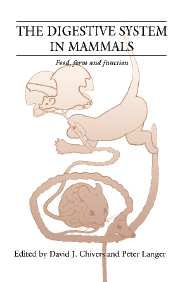Book contents
- Frontmatter
- Contents
- List of contributors
- Preface
- Part I Introduction
- Part II Food
- Part III Form
- 12 The form of selected regions of the gastro-intestinal tract
- 13 Categorisation of food items relevant to oral processing
- 14 A direct method for measurement of gross surface area of mammalian gastro-intestinal tracts
- 15 Morphometric methods for determining surface enlargement at the microscopic level in the large intestine and their application
- 16 Weaning time and bypass structures in the forestomachs of Marsupialia and Eutheria
- 17 Adaptations in the large intestine allowing small animals to eat fibrous foods
- Part IV Function
- Part V Synthesis and perspectives
- Index
13 - Categorisation of food items relevant to oral processing
Published online by Cambridge University Press: 18 March 2010
- Frontmatter
- Contents
- List of contributors
- Preface
- Part I Introduction
- Part II Food
- Part III Form
- 12 The form of selected regions of the gastro-intestinal tract
- 13 Categorisation of food items relevant to oral processing
- 14 A direct method for measurement of gross surface area of mammalian gastro-intestinal tracts
- 15 Morphometric methods for determining surface enlargement at the microscopic level in the large intestine and their application
- 16 Weaning time and bypass structures in the forestomachs of Marsupialia and Eutheria
- 17 Adaptations in the large intestine allowing small animals to eat fibrous foods
- Part IV Function
- Part V Synthesis and perspectives
- Index
Summary
Most terrestrial vertebrates use their teeth to guide food particles into the mouth and then swallow this food quickly. However, this ingestion procedure has been elaborated in mammals such that the teeth act together with soft tissues for longer periods to fracture food particles inside the mouth prior to swallowing. This process is called chewing or mastication and involves rhythmic cycles of muscle contraction and jaw movement (Hiiemae and Crompton, 1985). Overviews of the process that are based on the understanding of neuromuscular activity and its control (Otten, 1991) cannot as yet be integrated with the fracture mechanics of foods (Jeronimidis, 1991). So only one aspect is examined in this chapter: the contact of teeth with food. Firstly, a general theoretical outline of mastication is given, much of the supporting physiological evidence being derived from studies on humans. An attempt is then made to define the direction in which an efficient dentition would adapt to changes in the food input. Efficiency can be defined in two ways, either in terms of the rate at which the process runs (there are three possible definitions of masticatory rate) or energy expenditure. The predictions made here require much more study of the physical properties of the foods of mammals. This is difficult to do in the field. Most of the evidence discussed here relates to the diets of anthropoid primates because they are close relatives of the human and have been well-studied. Since these primates are largely herbivorous, only plant foods are treated in any detail.
Why chew?
Three reasons are offered for chewing food.
- Type
- Chapter
- Information
- The Digestive System in MammalsFood Form and Function, pp. 197 - 218Publisher: Cambridge University PressPrint publication year: 1994
- 14
- Cited by



